Everything You Need to Know About the Cyberpunk Art Style
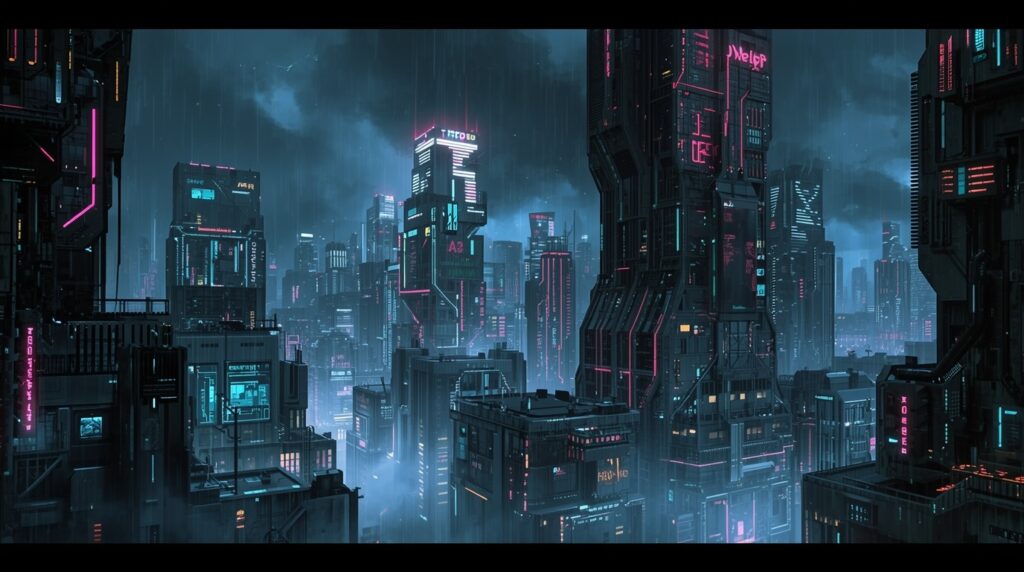
Stuck on your future city’s look? Timer’s on. Ideas stall.
Here’s the fix. Summon Worlds uses AI to turn rough notes into scenes, characters, and props, fast, on mobile.
This guide keeps it real. You’ll learn what cyberpunk art is, why it matters, and how to make it read as street life plus high tech. We’ll cover quick wins for neon lights, neon signs, color, and type. We’ll flag common mistakes. We’ll show simple, step-by-step workflows you can use today.
🍭Ready to make that city pop? Keep reading.
What Is Cyberpunk Art and Why It Matters Today
Cyberpunk art comes from the cyberpunk genre in science fiction. It shows a near future where life is rough but tech is advanced. People hustle under giant ads, wet streets, and the glow of screens. Think “low life, high tech.”
Two pillars shaped the look and feel. First is William Gibson and his novel Neuromancer (1984). It helped set the core ideas and even made the word “cyberspace” famous. The book pushed a world of hackers, corps, and street tech that artists still pull from today.
Second is Blade Runner (1982). The film’s city is dark, wet, and stacked with neon signs. The concept art by Syd Mead set the tone for crowded skylines, huge ads, smoke, and rain. That mood still guides the palette and lighting artists use for the style.
✍🏻The quick visual checklist
- Neon lights and backlit fog
- Dense streets with neon signs and screens
- Mix of old grit and high-tech gadgets
- Rain, reflections, and wet asphalt
- Foreign scripts, stacked ads, and tight alleys
- People first: the human story in the crush of machines
Hong Kong’s changing neon lights scene also shaped how we picture “future city” at night. Photographers and critics often link the Blade Runner mood to that glow.
How Cyberpunk Art Has Evolved Over Time
⏳Old approach: Paint a clean “utopian future.” Wide streets. White towers. No grime.
🚀Cyberpunk approach: Show crowded blocks and class gaps. Keep the tech slick, but the street messy. The point is contrast. This is why the style sits inside sci-fi yet feels close to our world.
⏰Today’s update: We still have rain, neon lights, and packed signage. Modern work also adds holograms, AR layers, drones, cheap implants, and corporate branding. The heart stays the same: the street fights back with style.
Cyberpunk Art Mistakes and How to Fix Them
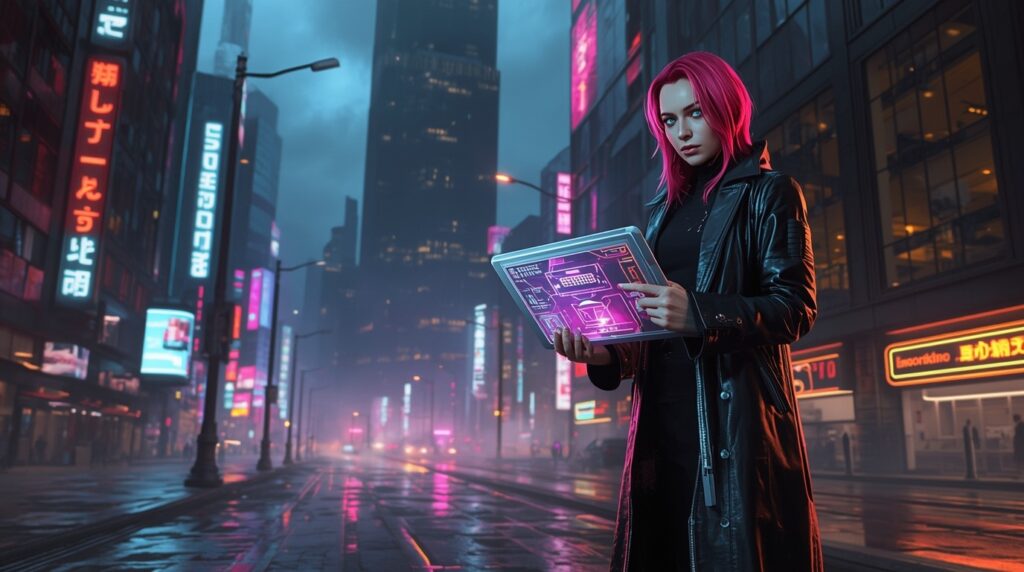
🌟Mistake 1: All glow, no story
Many pieces use bright magenta and teal but forget the human stake. Fix it with a small story beat: a courier in a hurry; a medic fixing a mod; a hacker at a food stall. The scene should show a choice, not just a backdrop.
🖥Mistake 2: Clean tech, clean street
Cyberpunk art loves shiny devices, but the city should feel used. Add grime, stickers, tape, and wear. Broken vents. Rust on rails. Old posters under new ads.
💬Mistake 3: Random fonts
Neon signs need hierarchy. Set one main typeface for big ads, then a simpler face for street labels. Keep sizes readable at a glance.
💡Mistake 4: Flat lighting
You want contrast. Put bright sources behind rain or smoke. Use rim light on faces. Let neon lights spill on wet ground. (This “contrarian” lighting choice is a big part of the Blade Runner mood.)
🎨Mistake 5: Colors with no logic
Pick a small palette. Example: cyan for corp branding, magenta for night food markets, amber for police drones. Repeat notes across signs and screens so the world feels linked. Research shows neon signs in these films often cycle blue, purple, red, yellow, and green.
✅Tiny digital tip: “click the layer”
In many editors, you can click the layer that holds your glow, then try a blend mode like Screen or Add. Lower opacity. Soften with a small blur. This boosts neon lights without washing out faces.
Key Features of the Cyberpunk Art Style
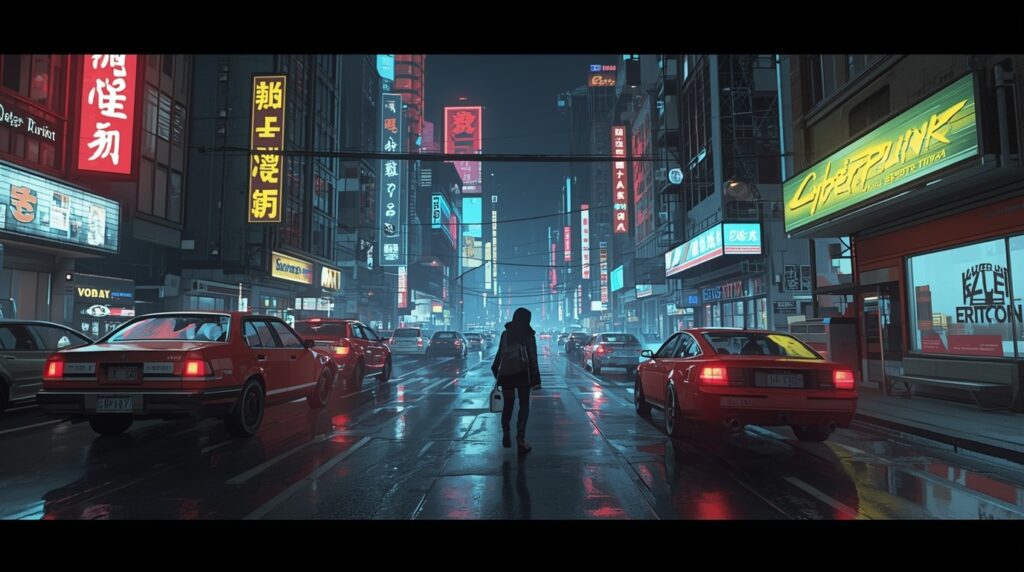
1) High contrast, low trust
Bright ads vs dark alleys. Big corps vs small crews. The style comes from the cyberpunk genre idea of outsiders up against systems. That “low life, high tech” push-pull defines the mood.
2) Urban density
Stacked neon signs, ducts, and cables. Narrow sight lines. Billboards at odd angles. All this sells scale and stress.
3) Tech as texture
Screens, wires, implants, drones. Tech is not just gear; it is set dressing. It fills space and creates light.
4) Rain makes it work
Wet surfaces reflect your lights and colors. This is a key reason Blade Runner feels so rich.
5) Roots in books and film
The look and themes come from science fiction writers and films. William Gibson shaped the tone with Neuromancer. Blade Runner shaped the camera and the city. Both still guide how we build the style today.
Create Cyberpunk Art in Summon Worlds (Step-by-Step Guide)
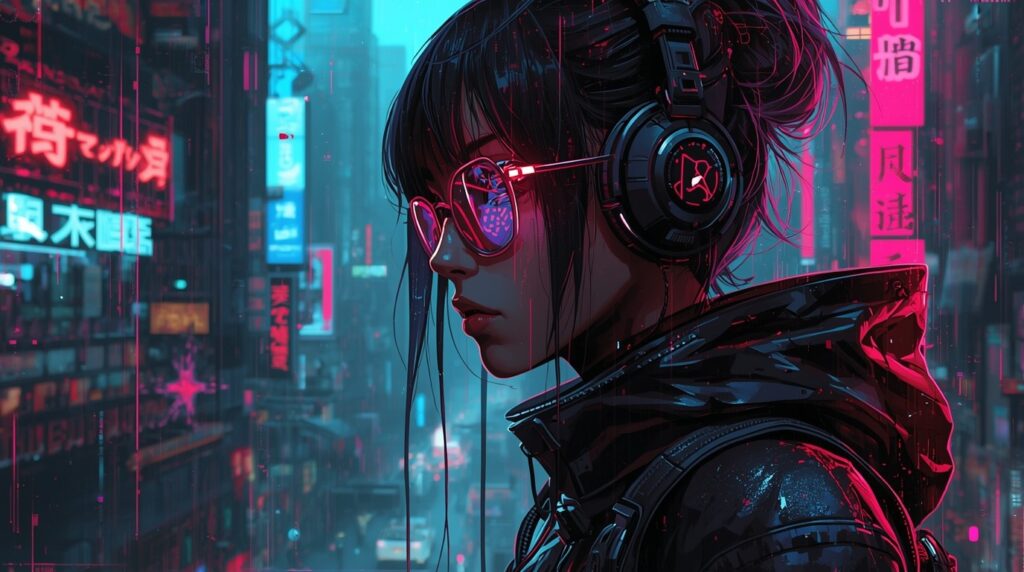
You came here to make things, not scroll theory. Here’s a clear path in Summon Worlds.
Step 1: Pick a clear goal
Choose one job per piece: a street sci fi medic, a drone cop, or a noodle stall at midnight. Small scope makes strong art.
Step 2: Use style presets
Choose a Futuristic look for hard surfaces and city glow. Use an Anime look for bold shapes and punchy color. Both styles fit cyberpunk art.
Step 3: Write a tight prompt
Template you can tweak:
“Set a night market alley in rain. Pack the scene with neon lights and neon signs. Let wet pavement mirror the glow. Let street steam drift. Send a small high tech drone with a police tag through the scene. Stretch cables overhead. Show a hooded runner in profile, tense. Keep a cyan-and-magenta base with amber accents. Aim for a crowded, loud, humid mood.”
👉🏻Save the prompt as a custom setup for later.
Step 4: Add realism with controls
- Enhance Chips: Sharpen key areas like faces, helmets, or signage.
- Extra Images: Generate a few more and pick the best.
- Legendary: Use when you want a bigger step up in detail.
- Draft or publish under your profile: Keep sets in Collections for fast access.
Step 5: Build a character that fits the street
Use Character Creation to set base stats and a backstory. Pick 5e Alignment if you play D&D. Edit the auto text so it matches your world’s slang and corp names.
Step 6: Give them a voice
Open AI Character Chat. Set Character Instructions so the voice is clipped, street-smart, and not chatty. Pick a voice in Voice Generation. Let the AI remember key beats with Context Memory. Now your runner can talk in-world.
Step 7: Expand with props
Spin up items: cyberdecks, medkits, smart guns, data crystals. Use Style Presets again so the set matches. Tag them for search. Drop them in Collections tied to the same crew or block.
Ready to Create Stunning Cyberpunk Art?
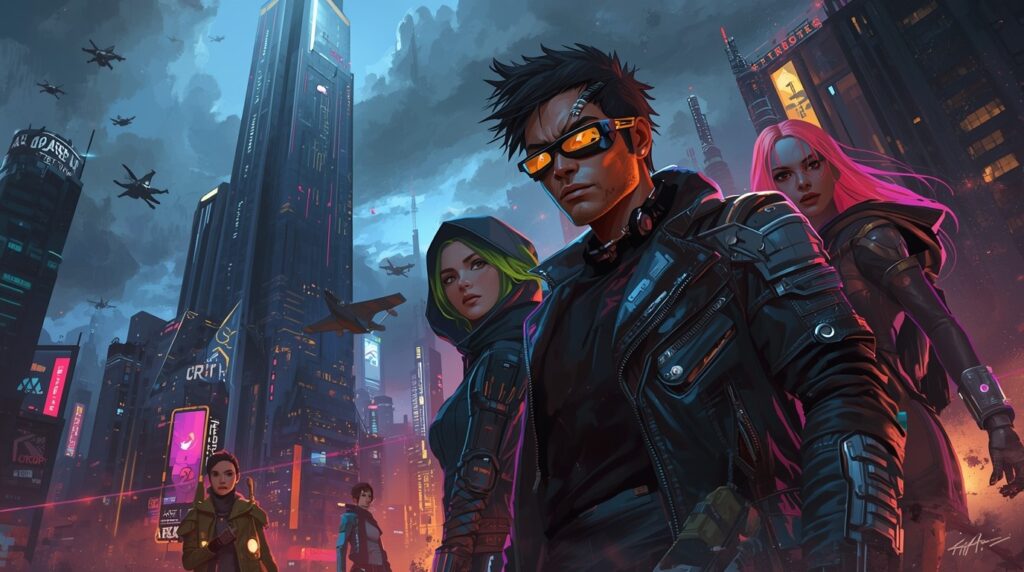
Cyberpunk art works because it feels human first. Start with a person. Layer worn high tech. Light with neon signs and rain. Keep colors small and strong. Pick clear, readable type. Add grit, stickers, and scuffs so the street breathes.
Summon Worlds helps you make this fast. Use Futuristic or Anime presets. Tune prompts for neon lights, wet roads, and dense ads. Generate Extra Images and keep the best. Spin up a character, set a voice in Character Chat, and keep the story moving. Save sets in Collections. Share when ready.
✨Want a quick win tonight? Install the app for free and build your first scene in minutes:
FAQ's
It’s a visual take on the cyberpunk genre. Think crowded cities, neon lights, rain, ads, and people trying to survive with high tech all around them. The roots tie back to science fiction books and films like Neuromancer and Blade Runner.
Limit the palette. Use cyan and magenta as a base. Add one warm accent like amber for contrast. Let neon signs reflect on wet ground. Keep skin tones readable. Research shows these films lean on alternating neon hues.
Because that film nailed the mood: rain, smoke, stacked ads, and backlit haze. Syd Mead shaped the look, and artists still riff on it.
Give your subject a goal. A courier is late for a drop. A parent repairing a kid’s implant. One clear human beat makes the tech matter.
Use AI Art Generation with Futuristic or Anime presets. Prompt for rain, neon lights, and cramped streets. Generate Extra Images, pick one, then build a matching character and chat with them to shape the story. Publish or keep drafts private.

